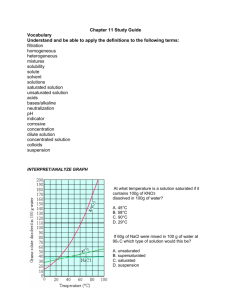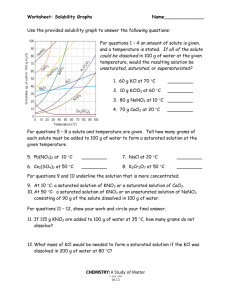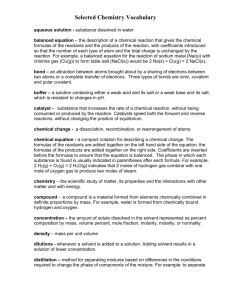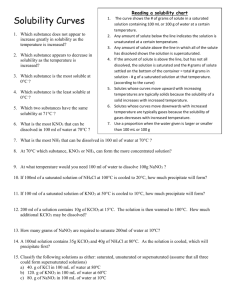solutions - kurtniedenzu
advertisement
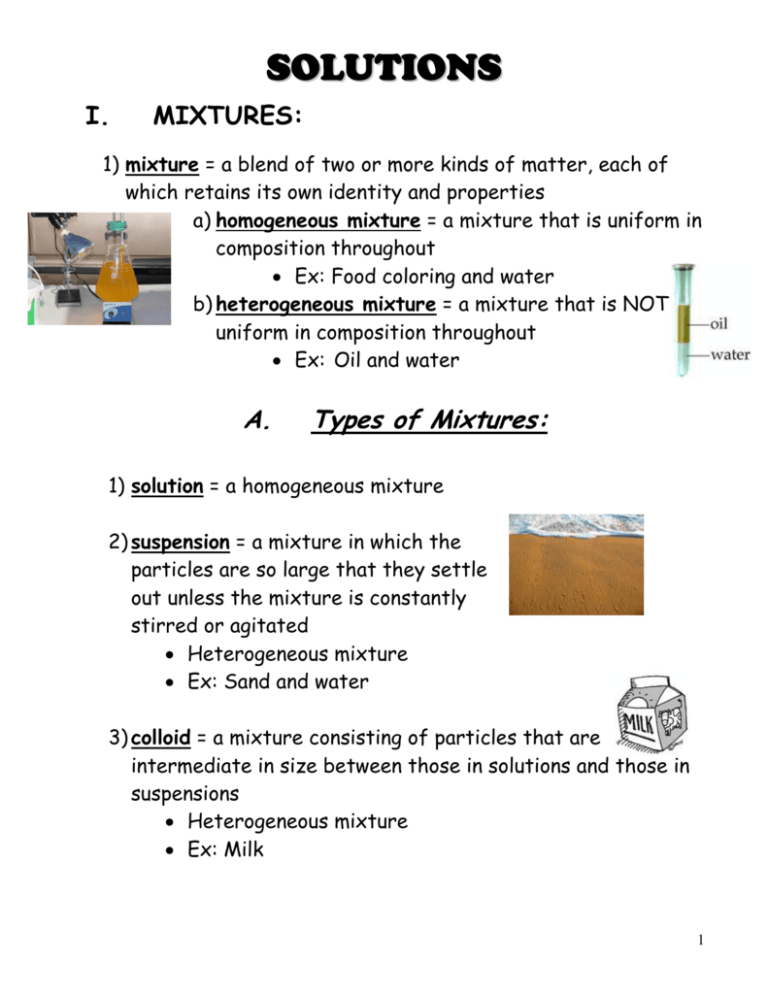
SOLUTIONS I. MIXTURES: 1) mixture = a blend of two or more kinds of matter, each of which retains its own identity and properties a) homogeneous mixture = a mixture that is uniform in composition throughout • Ex: Food coloring and water b) heterogeneous mixture = a mixture that is NOT uniform in composition throughout • Ex: Oil and water A. Types of Mixtures: 1) solution = a homogeneous mixture 2) suspension = a mixture in which the particles are so large that they settle out unless the mixture is constantly stirred or agitated • Heterogeneous mixture • Ex: Sand and water 3) colloid = a mixture consisting of particles that are intermediate in size between those in solutions and those in suspensions • Heterogeneous mixture • Ex: Milk 1 II. THE NATURE OF SOLUTIONS: 1) Solvent = the substance that does the dissolving in a solution a) Typically present in the greatest amount b) Typically a liquid c) Water is the most common or “universal” solvent 2) Solute = substance being dissolved in a solution a) Typically present in the least amount b) Typically a solid A. 9 Possible Solution Combinations: Solvent Gas Gas Gas Liquid Liquid Liquid Solid Solid Solid Solute Gas Liquid Solid Gas Liquid Solid Gas Liquid Solid B. Common Example Diver’s tank Humidity Moth ball Carbonation Vinegar Seawater Gas stove lighter Dental fillings Sterling Silver (Ag + Cu) o NOT all solutions are liquids/solids! o Solutions are formed in ALL 3 states! 3 Steps in Solution Formation: 1) Solute-solute attraction is broken up; requiring energy o Dissociation = separation of ions from each other in a solution Ex: NaCl + H2O – the Na ion and Cl ion become hydrated and gradually move away from the crystal into solution. 2 • Each ion in the solution acts as though it were present alone: So there is only a solution containing Na+ and Cl- ions uniformly mixed with H2O particles 2) Solvent-solvent attraction is broken up; requiring energy 3) Solute-solvent attraction is formed; releasing energy o Solvation = surrounding of solute particles by solvent particles C. Factors Affecting the Rate of Dissolving (Increase Solution Rate): 1) Grinding: increases surface area 2) Stirring: allows solvent continual contact with solute 3) Heating: increases kinetic energy; increases mixing 3 D. Electrolytes and Nonelectrolytes 1) electrolyte = a substance that dissolves in water to give a solution that conducts electric current 2) nonelectrolyte = a substance that dissolves in water to give a solution that does NOT conduct an electric current 3) Solutions of electrolytes can conduct electric current: 4 a) The positive ions and the negative ions disassociate (separate) in solution. The mobile ions can move a charge from one point in the solution to another point 4) Solutions of nonelectrolytes CANNOT conduct electric current: a) When a nonelectrolyte dissolves in water there are NO charged particles in solution. 5) Solid ionic compounds CANNOT conduct electric current: a) Ions are present but they are NOT mobile. E. SOLUBILITY: 1) Solubility = quantity of solute that will dissolve in specific amount of solvent at a certain temperature. (pressure must also be specified for gases). a) Ex: 204 g of sugar will dissolve in 100 g of water at 20°C b) soluble and insoluble are relative terms c) solubility should NOT be confused with the rate at which a substance dissolves 2) saturated solution = a stable solution in which the maximum amount of solute has been dissolved. 5 a) Visual evidence: a quantity of undissolved solute remains in contact with the solution 3) solution equilibrium = state where the solute is dissolving at the same rate that the solute is coming out of solution (crystallizing). a) Opposing processes of the dissolving and crystallizing of a solute occur at equal rates. b) solute + solvent solution 4) unsaturated solution = a solution that contains less solute than a saturated solution under existing conditions 5) supersaturated solution = a solution that temporarily contains more than the saturation amount of solute than the solvent can hold (unstable) F. 3 FACTORS EFFECTING SOLUBILITY: Ö The extent to which a given solute dissolves in a solvent depends on the identity of the solute and solvent and also on the existing conditions of pressure & temperature 1) Nature of solute and solvent a) “Like dissolves like” = rule of thumb for predicting whether or not one substance dissolves in another • “Alikeness” depends on: o Intermolecular forces “Like Dissolves Like” o Type of bonding 6 o Polarity or nonpolarity of molecules: ionic solutes tend to dissolve in polar solvents but not in nonpolar solvents Solvent-Solute Combinations: Solvent Type Polar Polar Nonpolar Nonpolar Solute Type Polar Nonpolar Polar Nonpolar Is Solution Likely? Yes No No Yes 2) Pressure: a) Pressure has little effect on the solubility of liquids or solids in liquid solvents. b)The solubility of a gas in a liquid solvent INCREASES when pressure increases. It is a direct relationship. 3) Temperature: a) The solubility of a gas in a liquid solvent DECREASES with an increase in temperature. b)The solubility of a solid in a liquid solvent MOST OFTEN increases with an increase in temperature. However, solubility changes vary widely with temperature changes sometimes decreasing with temperature increases. 7 III. SOLUBILITY CURVE: 1) Saturated = any point on the line or ABOVE the line • Point on the line = solution equilibrium 2) Unsaturated = any point BELOW the line 8 1. What is the solubility of the following solutes in water? a) NaCl at 60ºC = 38g b) KCl at 40ºC = 39g c) KNO3 at 20ºC = 31g 2. Are the following solutions saturated or unsaturated? Each solution contains 100 g of H20. a) 31.2 g of KCl at 30ºC = Unsaturated b) 106 g KNO3 at 60ºC = Saturated (on the line) c) 40 g NaCl at 10ºC = Saturated d) 150 g KNO3 at 90ºC = Unsaturated 3. For each of the following solutions, explain how much of the solute will dissolve and how much will remain undissolved at the bottom of the test tube? a) 180 g of KNO3 in 100 g of water at 80ºC ~11g undissolved; 169g dissolved b) 180 g of KNO3 in 100 g of water at 20ºC ~149g undissolved; 31g dissolved c) 60 g of NaCl in 100 g of water at 60ºC ~21g undissolved; 39g dissolved 4. A saturated solution of KNO3 is formed from one hundred grams of water. If the saturated solution is cooled from 90°C to 30°C, how many grams of precipitate are formed? (200g-45g) = 155g 5. A saturated solution of KCl is formed from one hundred grams of water. If the saturated solution is cooled from 90°C to 40°C, how many grams of precipitate are formed? (53g-39g) = 14g 9 IV. DISTINGUISHING BETWEEN THE TYPES OF MIXTURES: A. 3 types of MIXTURES: 1) solution = a homogeneous mixture 2) suspension = a mixture in which the particles are so large that they settle out unless the mixture is constantly stirred or agitated • Ex: Sand and water 3) colloid = a mixture consisting of particles that are intermediate in size between those in solutions and those in suspensions • Ex: Milk • Tyndall effect = visible pattern caused by the reflection of light from suspended particles in a colloid (or from suspended particles in a suspension if the particles have not settled out) o Ex: visibility of a headlight beam on a foggy night • Brownian motion = the random continuous motions of colloidal particles o Demo: chalk erasers 10 B. Classification of colloids based on the states of their dispersed and continuous phases: a) Aerosols = Liquids and solids dispersed in gases (fog, smoke) b) Foams = Gases dispersed in liquids (whipped cream) or in solids (marshmallows) c) Emulsions = liquids are dispersed in other liquids (mayonnaise) or in solids (cheese) d) Gels/Sols = solids dispersed in liquids (jelly, paint) or in solids (pearls, opals) 11 C. Properties of solution, colloids, and suspensions Solutions Colloids Suspensions Homogeneous Heterogeneous Heterogeneous Particle size: 0.01-1 nm; can be atoms, ions, molecules Particle size: 1-1000 nm, dispersed; can be aggregates or large molecules Particle size: over 1000 nm, suspended; can be large particles or aggregates Do not separate on standing Do not separate on standing Particles settle out Cannot be separated by filtration Cannot be separated by filtration Can be separated by filtration Do not scatter light Scatter light (Tyndall May scatter light, but are not transparent effect) D. Determining if a mixture is a true solution, a colloid, or a suspension: a) If particles settle or can be filtered out = suspension b) If particles DO NOT settle or filter out shine a beam of light (Tyndall effect) through the mixture • If the Tyndall effect is observed = colloid • If the Tyndall effect is NOT observed = solution 12 Solubility Curve Worksheet 1) Define solubility. 2) Look at the graph below. In general, how does temperature affect solubility? ________________________________________________________________________________ 3) Which compound is LEAST soluble at 10 °C? ______________________ 4) How many grams of KCl can be dissolved in 100g of water at 80°C? ______________________ 5) How many grams of NaCl can be dissolved in 100g of water at 90°C? ______________________ 6) At 40°C, how much KNO3 can be dissolved in 100g of water? ___________ 7) Which compound shows the least amount of change in solubility from 0°C-100°C? ________________ 8) At 30°C, 90g of NaNO3 is dissolved in 100g of water. Is this solution saturated or unsaturated? _____________ 9) At 60°C, 72g of NH4Cl is dissolved in 100g of water. Is this solution saturated or unsaturated? _____________ 10) A saturated solution of KClO3 is formed from one hundred grams of water. If the saturated solution is cooled from 90°C to 50°C, how many grams of precipitate are formed?_______________ 11) A saturated solution of NH4Cl is formed from one hundred grams of water. If the saturated solution is cooled from 80°C to 40°C, how many grams of precipitate are formed?_______________ 12) Which compounds show a decrease in solubility from 0°C-100°C? _____________________________ 13) Which compound is the most soluble at 10°C? _____________________________ 14) Which compound (besides Ce2(SO4)3) is the least soluble at 50°C?________________________ 15) For each of the following solutions, explain how much of the solute will dissolve and how much will remain undissolved at the bottom of the test tube? a) 120 g of KCl in 100 g of water at 80ºC _______________________________ _______________________________ b) 130 g of NaNO3 in 100 g of water at 50ºC _______________________________ _______________________________ 13 Solutions Review Worksheet 16) What are the 3 different types of mixtures? 17) What is a solution? 18) Classify each of the following as a heterogeneous mixture or a homogeneous mixture. a) salad _________________________________________ b) tap water _________________________________________ c) muddy water _________________________________________ 19) What is the difference between a solute and solvent? 20) What is considered to be the “universal solvent?_________________________ 21) Describe (in detail) the 3 steps in solution formation. 22) What is the difference between dissociation and solvation? 23) Not all solutions are solids dissolved in liquids. Provide 2 examples of other types of solutions. 24) EXPLAIN the 3 factors that affect the rate of dissolving? 14 25) Define solubility 26) What are 3 factors that affect solubility? a) ________________________________________ b) ________________________________________ c) ________________________________________ 27) Explain the rule, “Like Dissolves Like”. 6) State whether each of the following will conduct an electric current. Also, explain why each does or does not conduct an electric current. a) salt (NaCl) water b) sugar water c) solid NaCl 28) When does solution equilibrium occur? 29) What are the differences between a saturated solution, unsaturated solution and a supersaturated solution? 30) How could you tell by looking at a solution that it was saturated? 15 31) What is the Tyndall Effect? Cite a common example of this effect. 32) In what type of mixture is it easiest to separate the component substance? WHY? 33) Given an unknown mixture consisting of two substances, explain how a scientist could use lab techniques to determine whether the mixture is a true solution, a colloid, or a suspension. Use the solubility cure below to answer the following questions: 34) Which salt is LEAST soluble at 20 °C? ______________________ 35) How many grams of KBr can be dissolved in 100g of water at 60°C? ______________________ 36) How many grams of NaCl can be dissolved in 100g of water at 100°C? ______________________ 37) At 40°C, 180g of NaClO3 is dissolved in 100g of water. Is this solution saturated or unsaturated? _____________ 38) At 70°C, 70g of KBr is dissolved in 100g of water. Is this solution saturated or unsaturated? _____________ 39) A saturated solution of NaClO3 is formed from one hundred grams of water. If the saturated solution is cooled from 80°C to 60°C, how many grams of precipitate are formed?_______________ 40) How much of the solute will dissolve and how much will remain undissolved at the bottom of the test tube? a) 160 g of KNO3 in 100 g of water at 50ºC ___________________ ___________________ 16
